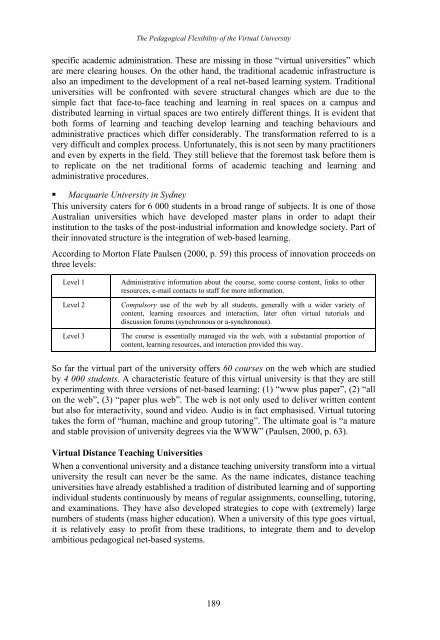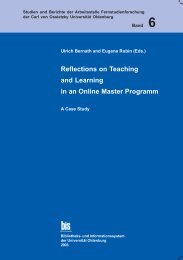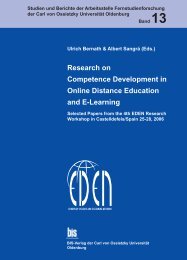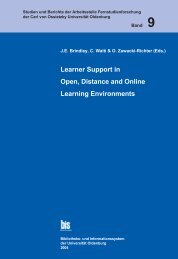Distance Education in Transition - Master of Distance Education ...
Distance Education in Transition - Master of Distance Education ...
Distance Education in Transition - Master of Distance Education ...
Create successful ePaper yourself
Turn your PDF publications into a flip-book with our unique Google optimized e-Paper software.
The Pedagogical Flexibility <strong>of</strong> the Virtual University<br />
specific academic adm<strong>in</strong>istration. These are miss<strong>in</strong>g <strong>in</strong> those “virtual universities” which<br />
are mere clear<strong>in</strong>g houses. On the other hand, the traditional academic <strong>in</strong>frastructure is<br />
also an impediment to the development <strong>of</strong> a real net-based learn<strong>in</strong>g system. Traditional<br />
universities will be confronted with severe structural changes which are due to the<br />
simple fact that face-to-face teach<strong>in</strong>g and learn<strong>in</strong>g <strong>in</strong> real spaces on a campus and<br />
distributed learn<strong>in</strong>g <strong>in</strong> virtual spaces are two entirely different th<strong>in</strong>gs. It is evident that<br />
both forms <strong>of</strong> learn<strong>in</strong>g and teach<strong>in</strong>g develop learn<strong>in</strong>g and teach<strong>in</strong>g behaviours and<br />
adm<strong>in</strong>istrative practices which differ considerably. The transformation referred to is a<br />
very difficult and complex process. Unfortunately, this is not seen by many practitioners<br />
and even by experts <strong>in</strong> the field. They still believe that the foremost task before them is<br />
to replicate on the net traditional forms <strong>of</strong> academic teach<strong>in</strong>g and learn<strong>in</strong>g and<br />
adm<strong>in</strong>istrative procedures.<br />
� Macquarie University <strong>in</strong> Sydney<br />
This university caters for 6 000 students <strong>in</strong> a broad range <strong>of</strong> subjects. It is one <strong>of</strong> those<br />
Australian universities which have developed master plans <strong>in</strong> order to adapt their<br />
<strong>in</strong>stitution to the tasks <strong>of</strong> the post-<strong>in</strong>dustrial <strong>in</strong>formation and knowledge society. Part <strong>of</strong><br />
their <strong>in</strong>novated structure is the <strong>in</strong>tegration <strong>of</strong> web-based learn<strong>in</strong>g.<br />
Accord<strong>in</strong>g to Morton Flate Paulsen (2000, p. 59) this process <strong>of</strong> <strong>in</strong>novation proceeds on<br />
three levels:<br />
Level 1 Adm<strong>in</strong>istrative <strong>in</strong>formation about the course, some course content, l<strong>in</strong>ks to other<br />
resources, e-mail contacts to staff for more <strong>in</strong>formation.<br />
Level 2 Compulsory use <strong>of</strong> the web by all students, generally with a wider variety <strong>of</strong><br />
content, learn<strong>in</strong>g resources and <strong>in</strong>teraction, later <strong>of</strong>ten virtual tutorials and<br />
discussion forums (synchronous or a-synchronous).<br />
Level 3 The course is essentially managed via the web, with a substantial proportion <strong>of</strong><br />
content, learn<strong>in</strong>g resources, and <strong>in</strong>teraction provided this way.<br />
So far the virtual part <strong>of</strong> the university <strong>of</strong>fers 60 courses on the web which are studied<br />
by 4 000 students. A characteristic feature <strong>of</strong> this virtual university is that they are still<br />
experiment<strong>in</strong>g with three versions <strong>of</strong> net-based learn<strong>in</strong>g: (1) “www plus paper”, (2) “all<br />
on the web”, (3) “paper plus web”. The web is not only used to deliver written content<br />
but also for <strong>in</strong>teractivity, sound and video. Audio is <strong>in</strong> fact emphasised. Virtual tutor<strong>in</strong>g<br />
takes the form <strong>of</strong> “human, mach<strong>in</strong>e and group tutor<strong>in</strong>g”. The ultimate goal is “a mature<br />
and stable provision <strong>of</strong> university degrees via the WWW” (Paulsen, 2000, p. 63).<br />
Virtual <strong>Distance</strong> Teach<strong>in</strong>g Universities<br />
When a conventional university and a distance teach<strong>in</strong>g university transform <strong>in</strong>to a virtual<br />
university the result can never be the same. As the name <strong>in</strong>dicates, distance teach<strong>in</strong>g<br />
universities have already established a tradition <strong>of</strong> distributed learn<strong>in</strong>g and <strong>of</strong> support<strong>in</strong>g<br />
<strong>in</strong>dividual students cont<strong>in</strong>uously by means <strong>of</strong> regular assignments, counsell<strong>in</strong>g, tutor<strong>in</strong>g,<br />
and exam<strong>in</strong>ations. They have also developed strategies to cope with (extremely) large<br />
numbers <strong>of</strong> students (mass higher education). When a university <strong>of</strong> this type goes virtual,<br />
it is relatively easy to pr<strong>of</strong>it from these traditions, to <strong>in</strong>tegrate them and to develop<br />
ambitious pedagogical net-based systems.<br />
189





